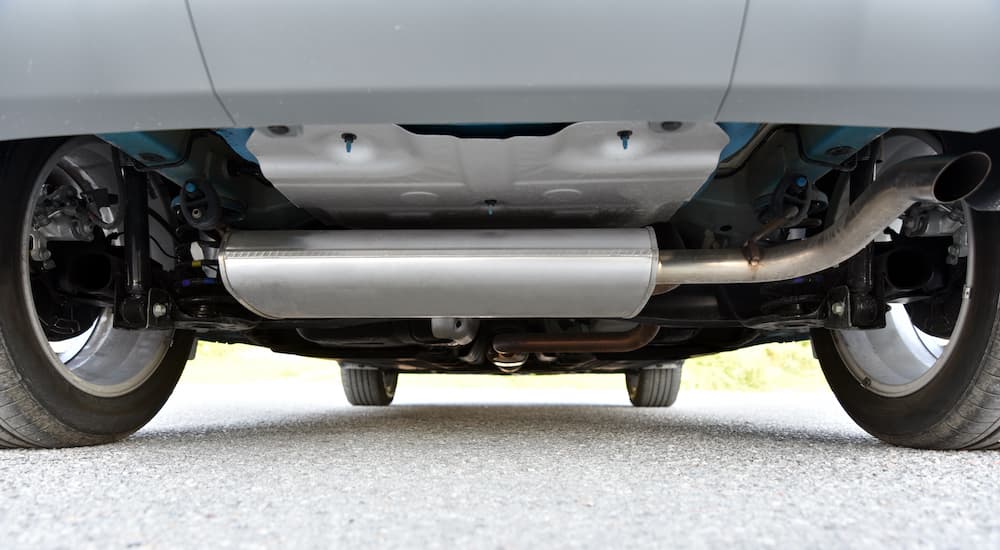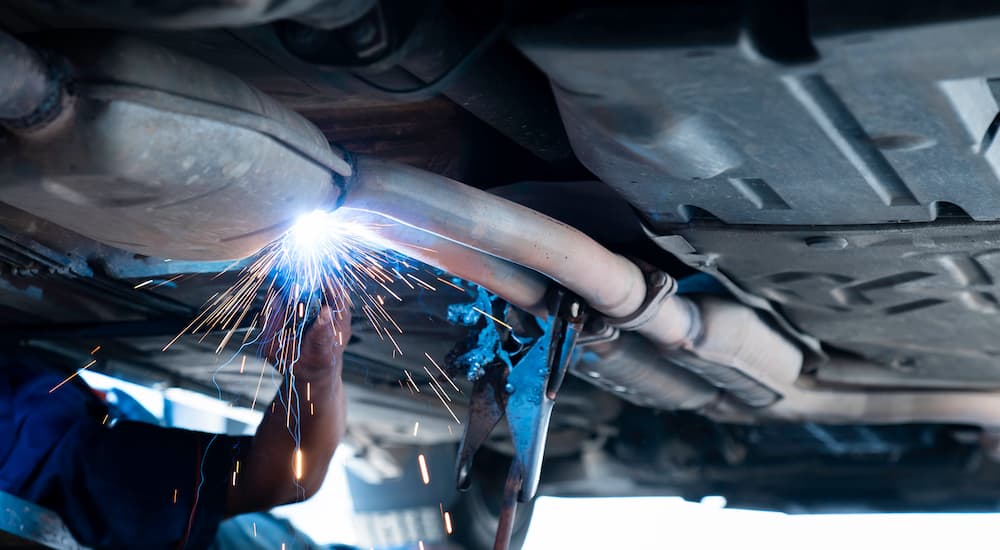For many drivers, the underside of their vehicle is somewhat of a mystery. Even the average DIY enthusiast won’t spend much time under their car outside of oil changes. Therefore, it’s only reasonable that drivers would have questions about the parts of a vehicle and how they work. One excellent question many drivers have is whether the exhaust and muffler are the same thing––an important question to get an answer to before visiting your local muffler service.
The muffler is part of your vehicle’s exhaust system, but the entirety of the exhaust encompasses far more than just the muffler. In fact, your vehicle’s exhaust is made of many different parts that help conduct gasses, heat, and noise away from you as you drive. The muffler is a part of this system, absorbing and reflecting the natural sounds of your car and its engine so that the human ear can tolerate the noise. Let’s take a closer look at your vehicle’s exhaust system as a whole and learn more about how the muffler fits into this very important equation.

The Basics Parts of an Exhaust System
Your vehicle’s exhaust system starts at the engine itself. If you drive a gasoline or diesel vehicle, the combination of fuel and oxygen creates a lot of heat and noise, as well as toxic chemicals. The purpose of an exhaust system is to remove the resulting gasses from your engine, clean them, quiet them, and send them back into the atmosphere.
The process starts at the exhaust manifold, where the gasses produced in the cylinders are collected and channeled away from the business area of the engine through a series of pipes or tubes. This journey then takes the gasses past the upstream oxygen sensor, which helps regulate your vehicle’s fuel consumption by checking the levels of both oxygen and harmful pollutants in your exhaust as it leaves the engine.
The catalytic converter then removes the dangerous chemicals that exist in the exhaust that has come directly from the engine. Rare metals such as platinum, palladium, and rhodium create a chemical reaction that turns those harmful elements into water vapor and carbon dioxide, both of which are relatively harmless. Bear in mind, though, that heat is still a major factor at this point, so it’s not a great idea to get up close and personal with a catalytic converter while it’s at work. In fact, intense heat is required to make the catalytic converter function.
Finally, the exhaust coming from your engine will pass through the resonator and the muffler before ultimately passing through the tailpipe and being released into the atmosphere.
What Does the Muffler Do?
As the name implies, the muffler exists to “muffle” the sound created by your vehicle as it operates. To understand how mufflers work––and why they’re necessary in the first place––it’s important to know the basics of how sound works. Engineers have a very deep and complex knowledge of how sound is created based on the activity of the engine at any given time, but don’t worry––we won’t get that detailed. However, knowing the basics of muffler technology can help you avoid big problems down the road if any part of your exhaust system should malfunction.
Sound is created by waves of high and low pressure. Again, this is a high-level overview of a very complex topic, but consider “sound” the waves that occur when there is a change in pressure. For example, when you gently close your car door, nothing really changes except the position of the door. But when you push it energetically, the pressure of air moving causes that little “whoosh” noise you hear, and the force of the various mechanisms that hold the door closed moving into place results in that “click” sound that lets you know the door is closed.
The activity in your engine is much more exciting, however. You have hot gasses moving around, air and fuel moving around, combustion, and a whole lot of high-temperature, high-pressure motion happening in a relatively small space. When high-pressure gas meets low-pressure atmosphere in the pipes of your exhaust system, they collide, they stack, and they move. The changes in pressure create pulses in the waves, which your ears and brain then interpret as an absolute racket. If you’ve ever spent time at a racetrack or even made a trip in a car without a muffler, you know that the sound can be quite literally deafening.
How Does a Muffler Work?
Mufflers are designed to cancel the sound. Inside the muffler, the gasses and sound waves first meet a resonator chamber. The size of this chamber is specifically calculated to allow sound waves to bounce through in perfect timing to cancel out the sound.
The inlet and outlet pipes within the body of the muffler are covered in tiny holes. These allow the sound waves to move around with direction, which ultimately helps them cancel each other out. The housing of the muffler is also designed from layers of insulating metal that are designed to absorb sound waves.
Many vehicles have a separate component known as the resonator. Much like the resonator chamber in the muffler, this part works to alter the sound of the exhaust to make it much more tolerable to the human ear. Separate resonators are often found on vehicles that are known for a “quiet” drive and are considered important parts of the overall exhaust system.
Some drivers are concerned about the amount of backpressure created by a muffler. While it’s true that a little power is subtracted by the process of directing pressure waves through the various chambers and holes in a muffler, the overall performance of your engine should not be greatly impacted by a well-functioning muffler. In fact, if you notice that your vehicle is starting to consume more fuel, lag in its response time, or produce extra heat and bad odors, you might want to check the exhaust system for possible problems.

Exhaust Systems and Mufflers in a Nutshell
Your exhaust system is crucial to the safe and legal operation of your vehicle. Though you can technically drive without one, it won’t be nearly as pleasant, nor will you pass a vehicle inspection. When you start hearing strange noises under your vehicle or start to smell strange fumes, it is likely time to visit your local exhaust shop to have your exhaust system inspected.
The exhaust system helps direct, clean, and quiet the exhaust as it travels from the engine to the open air. The muffler is an important step in this process, as this is where most of the noise from the combustion process is dampened, absorbed, and redirected so that it cancels itself out.
If you have ever driven any distance without a muffler, you’re likely grateful for this carefully engineered piece of equipment. While there are some drivers who prefer the roar, pop, and boom of a loud engine, the constant roar of today’s commuters would likely be difficult for many people to endure. Instead, we can thank the muffler for providing us with less noise, and thank the exhaust system for working diligently to keep us on the road.

